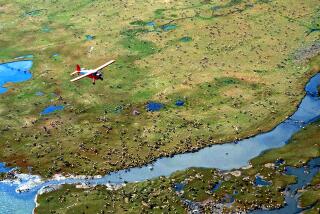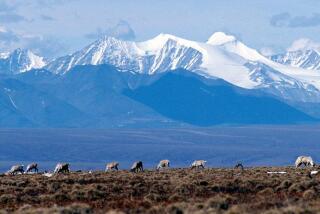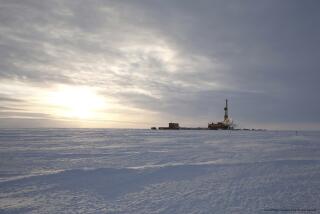Shell says Arctic drilling could begin next week in Chukchi Sea
WAINWRIGHT, Alaska — News that exploratory drilling in the Arctic could begin as early as next week brought a palpable sense of exuberance to the squat workers’ camp on the Chukchi Sea, where Shell Alaska has been slowly preparing to launch operations about 70 miles offshore.
“I’ve been waiting four years, coming up here to do this, and now I get to be here and be part of this new venture with the company. It’s exciting,” Travis McNair, supervisor of Shell’s oil spill response crew in this remote northwest Alaska coastal village, said in an interview.
“It does feel good, because of course we’ve been waiting for this for a long time. We’ve worked very, very hard to make sure we have everything in place,” said Chuck Holcomb, a 34-year Shell employee who has been coordinating the efforts of Shell scientists working across the Chukchi coast and several miles offshore.
Though Shell still does not have its final permits to drill, the U.S. Interior Department’s announcement that preliminary work can begin on a single well atop its most promising location — known as the Berger Prospect — means initial drilling could begin as early as next week, Shell’s Alaska operations Vice President Peter E. Slaiby told reporters Thursday in Anchorage.
“We’re excited about moving forward,” Slaiby said. “We’re not going to rush and get ourselves into a place where we’ve got any doubts. So far, everything’s looking very, very good.”
It is not at all clear that Shell will be able to reach hydrocarbon zones and complete drilling of the well before the Sept. 24 deadline set by the federal government to allow time to close the well before the onset of winter ice. The oil company, citing revised ice forecasts that show clear seas up through mid-November, has asked for an 18-day extension in the drilling window for the Chukchi Sea.
The preliminary authorization granted by the federal Bureau of Ocean Energy Management on Thursday allows commencement of the “top hole” of the well, which includes installation of a concrete-lined, 20-by-40-foot mud cellar about 350 feet below the surface. The installation would include a blowout preventer, a device for rapidly shutting off the well and the chief line of defense against an oil spill.
The initial part of the well’s so-called pilot hole could go down to about 1,300 feet, as allowed under the new federal authorization. But the drilling would still be at least 4,000 feet above any known hydrocarbon deposits, Slaiby said. Federal officials say no drilling will be permitted to continue deeper until the Arctic Challenger, an oil spill containment barge still undergoing final certification in Washington state, is in place midway between drilling sites in the Chukchi and Beaufort seas.
Company officials say they hope the Challenger could receive final U.S. Coast Guard certification as early as the middle of next week, then set sail on its two-week journey to the Arctic.
“We are in agreement with the Department of Interior we will not drill into any hydrocarbon zone without having the Arctic Challenger on line,” Slaiby said.
Shell engineers estimate it will take 20 to 24 days to drill the entire well, once they get full authorization, and an additional 10 days to evaluate whether it presents a good opportunity to recover produceable oil.
The Noble Discoverer, the rig slated for drilling in the Chukchi, is expected to arrive on site Friday or Saturday, take on fuel and provisions, and move to pick up its anchors at the drilling location sometime Saturday or Sunday.
Shell officials said they have not yet set a timeline for drilling to commence on a second well in the Beaufort Sea. Drilling there is presently foreclosed by the oil company’s agreement not to operate during the native Inupiat community’s fall whaling season, during the bowhead whale migration.
Drilling the Beaufort well could take place until Oct. 31, though the company is still awaiting final approval for the work.
Many of the nation’s major environmental groups were sharply critical of the decision to allow drilling to proceed before the oil containment system was complete and certified.
They also questioned allowing Shell to begin operations when the company has said it will not be able to meet its full original goal for reducing nitrogen oxide emissions from one of its drilling rigs -- though the company says it will still be operating the least-polluting drilling rig in the world.
Slaiby said the emissions performance gap is likely to affect the 2013 drilling season, not this year’s, but conservationists have argued against allowing any drilling to begin.
“Shell’s inability to meet the safety and pollution requirements it agreed to presents a disturbing trend,” Dan Ritzman, the Sierra Club’s Arctic program director, said in a statement. “The company must be held accountable at every step in the process. It should not be allowed to get a jump-start on drilling or extend its drilling season simply because of poor preparation.”
ALSO:
Aurora shooting: What happened to $5 million for victims?
Safest-driving cities: Sioux Falls tops list; D.C. is at the bottom
Amish beard-cutting: Shears cut symbol of manhood, expert says
More to Read
Sign up for Essential California
The most important California stories and recommendations in your inbox every morning.
You may occasionally receive promotional content from the Los Angeles Times.










